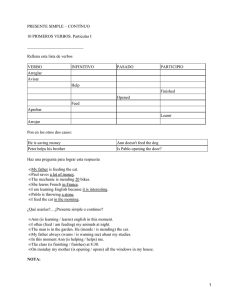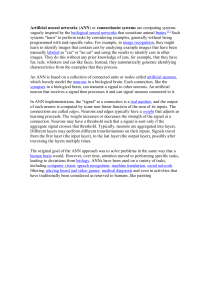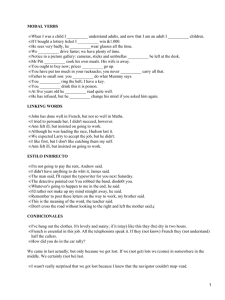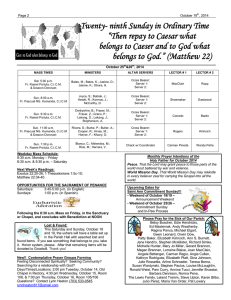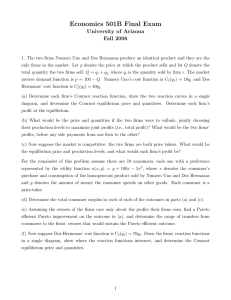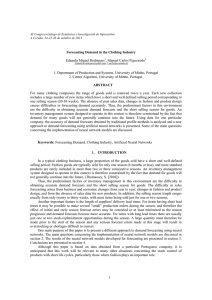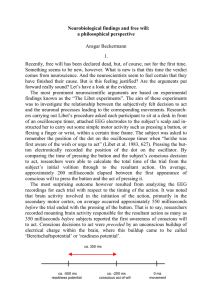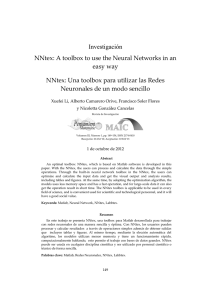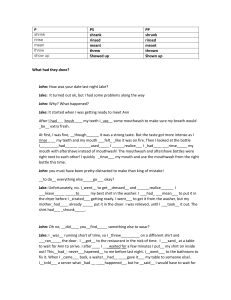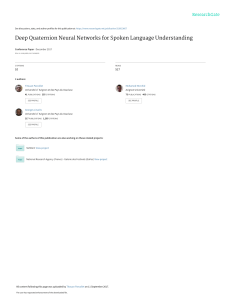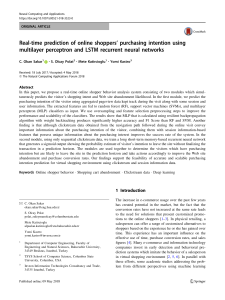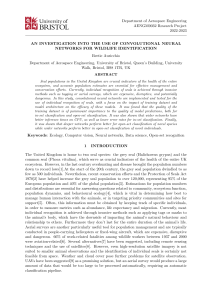Design of Artificial Neural Networks based on Genetic Algorithms to
Anuncio
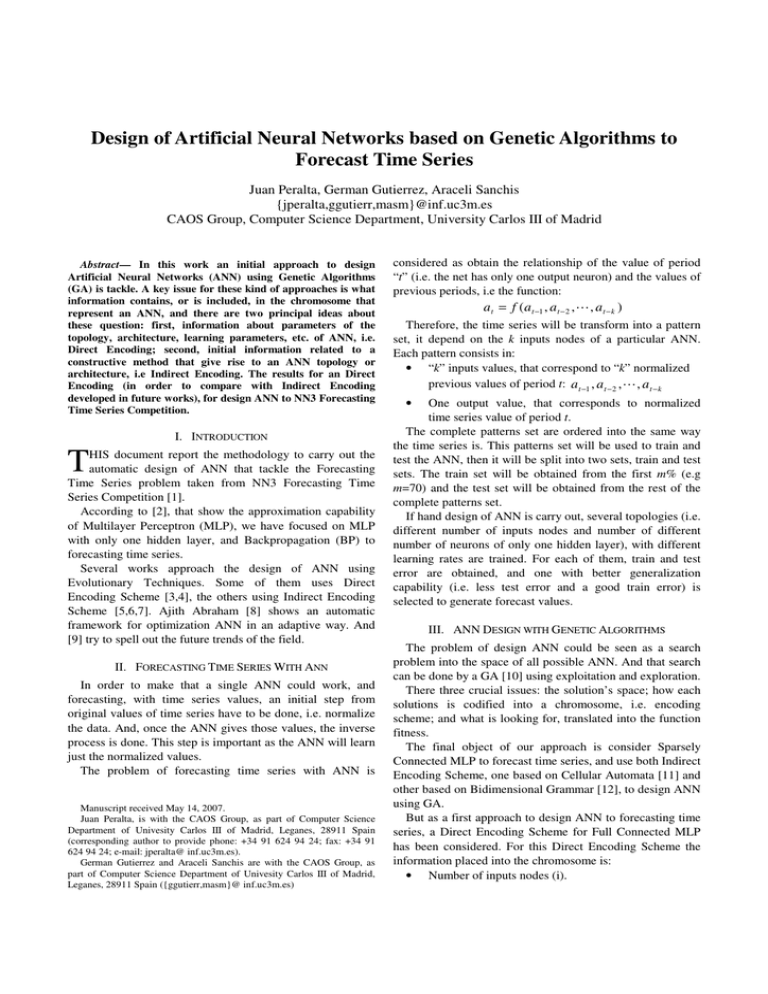
Design of Artificial Neural Networks based on Genetic Algorithms to
Forecast Time Series
Juan Peralta, German Gutierrez, Araceli Sanchis
{jperalta,ggutierr,masm}@inf.uc3m.es
CAOS Group, Computer Science Department, University Carlos III of Madrid
Abstract— In this work an initial approach to design
Artificial Neural Networks (ANN) using Genetic Algorithms
(GA) is tackle. A key issue for these kind of approaches is what
information contains, or is included, in the chromosome that
represent an ANN, and there are two principal ideas about
these question: first, information about parameters of the
topology, architecture, learning parameters, etc. of ANN, i.e.
Direct Encoding; second, initial information related to a
constructive method that give rise to an ANN topology or
architecture, i.e Indirect Encoding. The results for an Direct
Encoding (in order to compare with Indirect Encoding
developed in future works), for design ANN to NN3 Forecasting
Time Series Competition.
T
I. INTRODUCTION
HIS document report the methodology to carry out the
automatic design of ANN that tackle the Forecasting
Time Series problem taken from NN3 Forecasting Time
Series Competition [1].
According to [2], that show the approximation capability
of Multilayer Perceptron (MLP), we have focused on MLP
with only one hidden layer, and Backpropagation (BP) to
forecasting time series.
Several works approach the design of ANN using
Evolutionary Techniques. Some of them uses Direct
Encoding Scheme [3,4], the others using Indirect Encoding
Scheme [5,6,7]. Ajith Abraham [8] shows an automatic
framework for optimization ANN in an adaptive way. And
[9] try to spell out the future trends of the field.
II. FORECASTING TIME SERIES WITH ANN
In order to make that a single ANN could work, and
forecasting, with time series values, an initial step from
original values of time series have to be done, i.e. normalize
the data. And, once the ANN gives those values, the inverse
process is done. This step is important as the ANN will learn
just the normalized values.
The problem of forecasting time series with ANN is
Manuscript received May 14, 2007.
Juan Peralta, is with the CAOS Group, as part of Computer Science
Department of Univesity Carlos III of Madrid, Leganes, 28911 Spain
(corresponding author to provide phone: +34 91 624 94 24; fax: +34 91
624 94 24; e-mail: jperalta@ inf.uc3m.es).
German Gutierrez and Araceli Sanchis are with the CAOS Group, as
part of Computer Science Department of Univesity Carlos III of Madrid,
Leganes, 28911 Spain ({ggutierr,masm}@ inf.uc3m.es)
considered as obtain the relationship of the value of period
“t” (i.e. the net has only one output neuron) and the values of
previous periods, i.e the function:
a t = f ( a t −1 , a t − 2 ,
, at − k )
Therefore, the time series will be transform into a pattern
set, it depend on the k inputs nodes of a particular ANN.
Each pattern consists in:
• “k” inputs values, that correspond to “k” normalized
previous values of period t: a t −1 , a t − 2 , , a t − k
•
One output value, that corresponds to normalized
time series value of period t.
The complete patterns set are ordered into the same way
the time series is. This patterns set will be used to train and
test the ANN, then it will be split into two sets, train and test
sets. The train set will be obtained from the first m% (e.g
m=70) and the test set will be obtained from the rest of the
complete patterns set.
If hand design of ANN is carry out, several topologies (i.e.
different number of inputs nodes and number of different
number of neurons of only one hidden layer), with different
learning rates are trained. For each of them, train and test
error are obtained, and one with better generalization
capability (i.e. less test error and a good train error) is
selected to generate forecast values.
III. ANN DESIGN WITH GENETIC ALGORITHMS
The problem of design ANN could be seen as a search
problem into the space of all possible ANN. And that search
can be done by a GA [10] using exploitation and exploration.
There three crucial issues: the solution’s space; how each
solutions is codified into a chromosome, i.e. encoding
scheme; and what is looking for, translated into the function
fitness.
The final object of our approach is consider Sparsely
Connected MLP to forecast time series, and use both Indirect
Encoding Scheme, one based on Cellular Automata [11] and
other based on Bidimensional Grammar [12], to design ANN
using GA.
But as a first approach to design ANN to forecasting time
series, a Direct Encoding Scheme for Full Connected MLP
has been considered. For this Direct Encoding Scheme the
information placed into the chromosome is:
• Number of inputs nodes (i).
• Number of hidden nodes (h).
• Learning rate, for BP learning algorithm ( ).
The value of learning rate, “ ”, is between 0 and 1, and
the value of “i” and “h” is limited by a maximum number of
inputs nodes (max_inputs) and a maximum number of hidden
nodes (max_hidden), respectively. These maximum values
are related, by a factor “a”, with the number of periods of
time series what values are known (nts), see (1)
max_ inputs = a × nts;
individual from all generations is used to forecast the time
series.
IV. CONCLUSION
The final object of our approach is consider Sparsely
Connected MLP to forecast time series, and use both Indirect
Encoding Scheme, one based on Cellular Automata [11] and
other based on Bidimensional Grammar [12], to design ANN
using GA.
max_ hidden = 2 × max_ inputs; (1)
a = 0.3
Into the chromosome, two decimal digits, i.e two genes,
are used to codified the value “i”, other two for “h” and the
last two for “ ”. This way,the values of “i”, “h” and “ ” are
obtained, from the chromosome, as it can see in (2)
chrom : gi1 gi2 gh1 gh2 gα 1 gα 2
( gi ⋅ 10 + gi2 )
i = max_ inputs × 1
;
100
( gh1 ⋅ 10 + gh2 ) (2)
h = max_ hiddens ×
;
100
( gα 1 ⋅ 10 + gα 2 )
α=
100
The search process that GA is, begins with a random
population, i.e set of randomly generated chromosomes.
Later, the fitness value for each one of the individual of the
population is obtained (a). Once that it is already done the
GA operators as Elitism, Selection, Crossover and Mutation
are applied in order to generate the population of next
generation, i.e. set of chromosomes (b). The steps (a) and (b)
are iteratively executed till a maximun number of
generations is reached.
To obtained the fitness value of a chromosome:
1. The train patterns and test patterns sets are
obtained, dependending on the number of inputs
nodes of the net, as was said above (sec.II).
2. Then, the connection wegihts are randomly
initialized, and the net is trained (using Stuttgart
Neural Network Simulator (SNNS) binary tools
[13]) a maximum training cycles.
The fitness value will be the minimun error test reached in
training process, it doesn´t have to be in the last training
cycle. The architecture of the net (topology + connections
weights) when the test error is minimum in training process
is saved to be used later for forecasting time series values.
Once that GA reaches the last generation, the best
APPENDIX
Stuttgart Neural Network Simulator (SNNS) binary tools
[13], ff_bignet and batchman, has been used for generate ánd
training ANN.
The
whole
source
code
is
available
in
{ggutierr,jperalta}@inf.uc3m.es.
REFERENCES
[1]
[2]
[3]
[4]
[5]
[6]
[7]
[8]
[9]
[10]
[11]
[12]
[13]
2006/07 Forecasting Competition for Neural Networks &
Computational Intelligence. http://www.neural-forecastingcompetition.com/
G. Cybenko. Approximation by superposition of a sigmoidal function.
Mathematics of Control, Signals and Systems, 2, 303-314, 1989
T. Ash. Dynamic Node Creation in Backpropagation Networks ICS
Report 8901, The Institute for Cognitive Science, University of
California, San Diego (Saiensu-sh, 1988), 1988
] D.B. Fogel, Fogel L.J. and Porto V.W. Evolving Neural Network,
Biological Cybernetics, 63, 487-493, 1990.
Gruau F. “Genetic Synthesis of Boolean Neural Netorks with a Cell
Rewriting Developmental Process”. Proceedings of COGANN-92
International Workshop on Combinations of Genetic Algorithms and
Neural Networks, pp. 55-74, IEEE Computer Society Press, 1992.
Yao, X. and Lin, Y. A new evolutionary system for evolving artificial
neural networks, Transactions on Neural Networks, 8(3): 694-713,
1997.
Kitano, H.: Designing Neural Networks using Genetic Algorithms
with Graph Generation System, Complex Systems, 4, 461-476, 1990.
Ajith Abraham, Meta-Learning Evolutionary Artificial Neural
Networks, Neurocomputing Journal, Elsevier Science, Netherlands,
Vol. 56c, pp. 1-38, 2004.
] H. Garis, D. Fogel, M. Conrad and X. Yao. Special Issue on
evolutionary neural systems. Neurocomputing, 42, 1-8, 2002
Fogel, D. Evolutionary Computation: Toward a New Philosophy of
Machine Intelligence. Wiley-IEEE Press, 1998
Non-direct Encoding method based on Cellular Automata to design
Neural Network Architectures. G. Gutiérrez, A. Sanchis, P. Isasi, J.M.
Molina and I. M. Galván. Computer and Informatics, 24 2005, No3.
Studying the Capacity of Grammatical Encoding to Generate FNN
Architectures. Germán Gutiérrez, Beatriz García, José M. Molina and
Araceli Sanchis. Computational Methods in Neural Modeling, Lecture
Notes in Computer Science, Volume 2686/2003. IWANN 2003
Prof. Dr. Andreas Zell,, WSI Computer Science Department,
Computer Arquitecture, Software, Artificial Neural Networks
<http://www-ra.informatik.uni-tuebingen.de/SNNS/>
